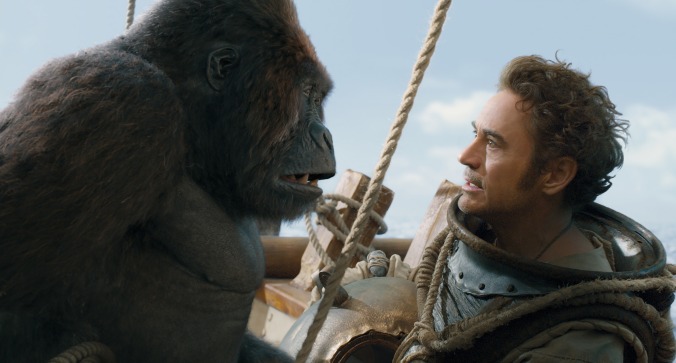Robert Downey Jr. could have done less in Dolittle

Who is Robert Downey Jr.’s performance as the title character of Dolittle for, exactly? It’s a snuffling, shuffling, head-twitching collection of tics, with a physicality that’s more evocative of a nervous squirrel than the actual CGI squirrel who accompanies Dr. Dolittle on his adventures across the sea. Downey’s exaggerated jerks and fits in the film recall Johnny Depp’s turn as Jack Sparrow in the Pirates Of The Caribbean movies, with one key difference: As annoying as Depp’s quirk-based acting style can be, it made sense for the captain of a pirate ship to be flamboyant. For a Victorian-era physician with a magical gift for understanding animal languages, the choice feels arbitrary. (Neither Rex Harrison nor Eddie Murphy played the character as if he’d been dosed with an obscure hallucinogen, after all.) It once again raises the question of why director Stephen Gaghan (Syriana) asked Downey to act that way—or perhaps, why he didn’t ask him to tone it down a little.
It’s not the only chaotic thing about Dolittle, a real food fight of a movie that’s ostensibly based on a book: Hugh Lofting’s The Voyages Of Doctor Dolittle (1922), the sprawling second novel in his series. As one might expect, however, the film goes off-book very quickly, so the literary influence here is minimal. What replaces it is a confused, sweaty, zigzag approach to storytelling, which waves away inconvenient details and waves in lame jokes with an equal sense of desperation. The basic premise is that Dolittle has withdrawn from human society after the loss of his beloved wife, Lily (Kasia Smutniak), an explorer who died at sea. He now spends his days surrounded by his animal friends, including a duck named Jab-Jab (Octavia Spencer); a gorilla named Chee-Chee (Rami Malek); a polar bear named Yoshi (John Cena); an ostrich named Plimpton (Kumail Nanjiani); and a parrot named Poly (Emma Thompson), the voice of reason and responsibility in this eccentric menagerie.
But there’s not much of a movie if Dr. Dolittle stays within the walls of his estate. And so the very Victorian combination of a child aristocrat (Lady Rose, played by Carmel Laniado) and a plucky boy in a newsie cap (Tommy Stubbins, played by Harry Collett) arrive at his doorstep in the first act, drawing Dolittle out of zoological retirement by invoking the also very Victorian value of loyalty to his monarch (Jessie Buckley), who’s been stricken with a mysterious illness and needs Dolittle’s help. (If you’re asking yourself at this point, “Isn’t Dr. Dolittle a veterinarian?” the answer is, sort of. He can treat humans, but he prefers not to.) And thus Dolittle, Lady Rose, Tommy, and the animals take off on a Pirates-style voyage across the sea for a magical fruit that will cure the queen of her malady. Along the way, they encounter magical creatures like Antonio Banderas and an irritable dragon with an impacted colon, who Dolittle cures by—how to put this delicately?—sticking his arm up her butt and pulling out a bagpipe.
That’s typical of the film’s humor, which reeks of after-the-fact punch-up prompted by negative test-audience feedback. That is to say, Dolittle is full of anachronistic pop culture references and poop and fart humor, jokes delivered in suspiciously low-impact style by the film’s animated animals. Occasionally, a bit pops up that’s specific to a particular species, like the scene where Dolittle escapes the jaws of a man-eating tiger by waving a mirror like a laser pointer. These are actually lightly amusing, as is Michael Sheen’s over-the-top performance as Dolittle’s sworn rival, the sputtering incarnation of medical mediocrity Dr. Blair Müdfly. The key there is that Sheen is not taking his role even remotely seriously, and is playing for the amusement of the children in the audience rather than operating by a misguided faith in the power of one-liners or a myopic conception of his movie-star brilliance. Would that everyone else involved in this production had the same clarity.